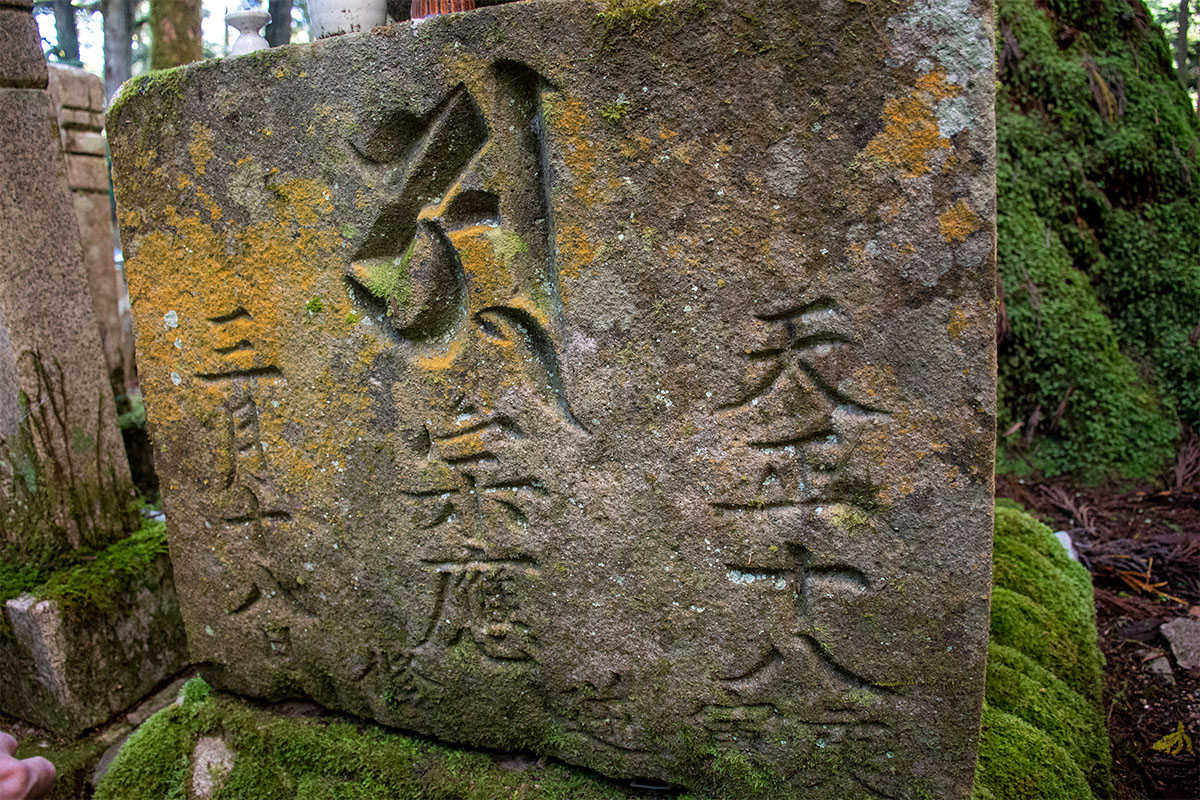KoyaQuest
Tomb of Ishida Mitsunari

Tomb of Ishida Mitsunari

Tomb of Ishida Mitsunari
A loyal ally of Toyotomi Hideyoshi, Ishida Mitsunari (1559-1600) is best known for his defeat at the battle of Sekigahara in the year 1600. This loss by loyalists to the late Toyotomi Hideyoshi made Tokugawa Ieyasu the most powerful man in Japan and ushered in the three-century long rule of the Tokugawa Shogunate.
What makes Mitsunari's memorial remarkable is an inscription on the bottom stone. There, alongside the Sanskrit letter for "earth," we see the date given as the 18th year of the Tenshō Era. This corresponds to the year 1590, ten years before Mitsunari's death.

The date flanks Mitsunari's posthumous Buddhist name (宗應 Shūou) at the center, and below this we see a term (逆修 gyakushū) suggesting that Mitsunari erected the memorial in anticipation of his own death - perhaps before the Siege of Odawara Castle.
Some people believe that the creation of a spiritual monument while Mitsunari was still in his prime was intended to galvanize his bravery as a warrior. If one has prepared himself for the afterlife, the logic goes, what is left to fear?
It is worth mentioning how this flattering interpretation seems to conflict with a well known anecdote concerning Mitsunari's actual death: While awaiting execution in Kyoto after the Battle of Sekigahara, Mitsunari was thirsty and asked for water. Because there was none at hand (which seems unlikely), he was offered a persimmon. Mitsunari refused, saying that the fruit made him constipated. The men who were guarding Mitsunari found it curious that someone who was about to have his head lopped off would have such a concern.

At 2.67 meters in height, Mitsunari's monument is smaller than those erected in later years for other famous daimyō. However, at the time it was built it would have been one of the more impressive monuments at Oku-no-in. Because Mitsunari at age 30 was of modest wealth, his rather extravagant outlay on his monument is taken as a sign of his deep faith in Kōbō-daishi.
Further evidence of this devotion is found in a sutra repository located near Kōbō-daishi's mausoleum. Mistunari donated this building to Mt. Kōya in remembrance of his mother.
Lorem ipsum dolor sit amet, consectetur adipisicing elit, sed do eiusmod tempor incididunt ut labore et dolore magna aliqua. Ut enim ad minim veniam, quis nostrud exercitation ullamco laboris nisi ut aliquip ex ea commodo consequat. Duis aute irure dolor in reprehenderit in voluptate velit esse cillum dolore eu fugiat nulla pariatur. Excepteur sint occaecat cupidatat non proident, sunt in culpa qui officia deserunt mollit anim id est laborum.
Lorem ipsum dolor sit amet, consectetur adipisicing elit, sed do eiusmod tempor incididunt ut labore et dolore magna aliqua. Ut enim ad minim veniam, quis nostrud exercitation ullamco laboris nisi ut aliquip ex ea commodo consequat. Duis aute irure dolor in reprehenderit in voluptate velit esse cillum dolore eu fugiat nulla pariatur. Excepteur sint occaecat cupidatat non proident, sunt in culpa qui officia deserunt mollit anim id est laborum.
Lorem ipsum dolor sit amet, consectetur adipisicing elit, sed do eiusmod tempor incididunt ut labore et dolore magna aliqua. Ut enim ad minim veniam, quis nostrud exercitation ullamco laboris nisi ut aliquip ex ea commodo consequat. Duis aute irure dolor in reprehenderit in voluptate velit esse cillum dolore eu fugiat nulla pariatur. Excepteur sint occaecat cupidatat non proident, sunt in culpa qui officia deserunt mollit anim id est laborum.
Lorem ipsum dolor sit amet, consectetur adipisicing elit, sed do eiusmod tempor incididunt ut labore et dolore magna aliqua. Ut enim ad minim veniam, quis nostrud exercitation ullamco laboris nisi ut aliquip ex ea commodo consequat. Duis aute irure dolor in reprehenderit in voluptate velit esse cillum dolore eu fugiat nulla pariatur. Excepteur sint occaecat cupidatat non proident, sunt in culpa qui officia deserunt mollit anim id est laborum.
© 2025, k. collins